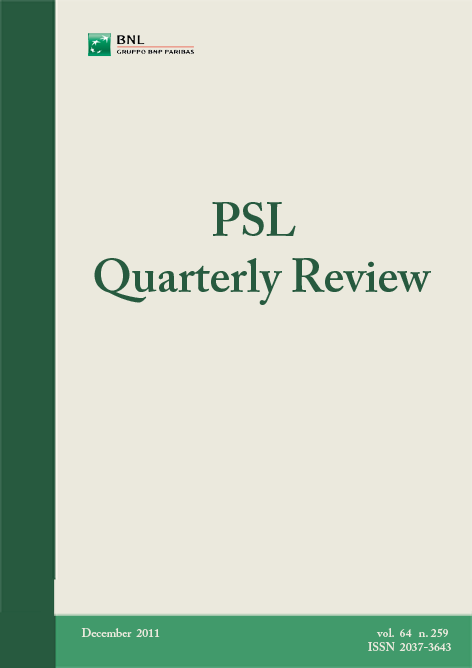The remarkable durability of Thirlwall’s Law
DOI:
https://doi.org/10.13133/2037-3643/9406Keywords:
Thirlwall’s law, balance-of-payments-constrained growth, export-led growth, demand-led growth, natural rate of growthAbstract
This paper contemplates the robustness of Thirlwall’s Law, a parsimonious expression that relates long run equilibrium growth in any one region to the product of world income growth and the ratio of the income elasticities of demand for exports and imports. Various extensions of the balance-of-payments-constrained growth model from which Thirlwall’s Law is derived are contemplated. In each case, Thirlwall’s Law is shown to reassert itself as a good approximation of the equilibrium growth rate. It is hypothesized that this robustness helps explain the widespread empirical success of Thirlwall’s Law.
JEL Codes: O41, E12
References
ARAÚJO R.A., LIMA G.T. (2007), “A structural economic dynamics approach to balance of payments-constrained growth”, Cambridge Journal of Economics, vol. 31, pp. 755-774.
BLECKER R. (2009), “Long-run growth in open economies: export-led cumulative causation or a balance-of-payments constraint?”, paper prepared for the 2nd summer school on Keynesian macroeconomics and European economic policies, Berlin, 2-9 August 2009.
CORNWALL J. (1977), Modern capitalism: its growth and transformation, London: Martin Robertson.
CORNWALL J., CORNWALL W. (2002), “A demand and supply analysis of productivity growth”, Structural Change and Economic Dynamics, vol. 13, pp. 203-229.
DIXON R., THIRLWALL A.P. (1975), “A model of regional growth rate differences along Kaldorian lines”, Oxford Economic Papers, vol. 27, pp. 201-214.
GARCIMARTÍN C., RIVAS L.A., MARTÍNEZ P.G. (2010), “On the role of relative prices and capital flows in balance-of-payments-constrained growth: the experiences of Portugal and Spain in the euro area”, Journal of Post Keynesian Economics, vol. 33, pp. 281-305.
HUGHES J.J., THIRLWALL A.P. (1979), “Imports and labour market bottlenecks: a disaggregated study for the U.K.”, Applied Economics, vol. 11, pp. 77-94.
KALDOR N. (1970), “The case for regional policies”, Scottish Journal of Political Economy, vol. 17, pp. 337-348.
KALDOR N. (1983), “Keynesian economics after fifty years”, in Worswick D. and Trevithick J. (eds.), Keynes and the modern world, Cambridge: Cambridge University Press.
KALDOR N. (1985), Economics without equilibrium, Cardiff: University College Cardiff Press.
KALDOR N. (1996), Causes of growth and stagnation in the world economy, Cambridge: Cambridge University Press.
KING J. (2010), “Kaldor and the Kaldorians”, in Setterfield M. (ed.), Handbook of alternative theories of economic growth, Cheltenham: Edward Elgar, pp. 157-172.
KRUGMAN P. (1989), “Differences in income elasticities and trends in real exchange rates”, European Economic Review, vol. 33, pp. 1031-1054.
LEÓN-LEDESMA M., THIRLWALL A.P. (2000), “Is the natural rate of growth exogenous”, BNL Quarterly Review, n. 215, pp. 433-445.
LEÓN-LEDESMA M., THIRLWALL A.P. (2002), “The endogeneity of the natural rate of growth”, Cambridge Journal of Economics, vol. 26, pp. 441–459.
LEÓN-LEDESMA M., LANZAFAME M. (2010), “The endogenous nature of the ‘natural’ rate of growth”, in Setterfield M. (ed.), Handbook of alternative theories of economic growth, Cheltenham: Edward Elgar, pp. 208-219.
MADDISON A. (1991), Dynamic forces in capitalist development, Oxford: Oxford University Press.
MCCOMBIE J.S.L., THIRLWALL A.P. (1994), Economic growth and the balance-ofpayments constraint, London: Macmillan.
MCCOMBIE J.S.L., ROBERTS M. (2002), “The role of the balance of payments in economic growth”, in Setterfield M. (ed.), The economics of demand-led growth: challenging the supply-side vision of the long run, Cheltenham: Edward Elgar, pp. 87-114.
MCCOMBIE J.S.L., PUGNO M., SORO B. (eds.) (2002), Productivity growth and economic performance: essays on Verdoorn’s Law, London: Palgrave Macmillan.
MORENO-BRID J.C. (1998), “On capital flows and the balance-of-payments-constrained growth model”, Journal of Post Keynesian Economics, vol. 21, pp. 283-298.
NELL K.S. (2003), “A ‘generalized’ version of the balance-of-payments growth model: an application to neighbouring regions”, International Review of Applied Economics, vol. 17, pp. 249-267.
PALLEY T.I. (2002), “Pitfalls in the theory of growth: an application to the balance-ofpayments- constrained growth model”, in Setterfield M. (ed.), The economics of demand-led growth: challenging the supply-side vision of the long run, Cheltenham: Edward Elgar, pp. 115-125.
PASINETTI L. (1981), Structural change and economic growth: a theoretical essay on the dynamics of the wealth of nations, Cambridge: Cambridge University Press.
PASINETTI L. (1993), Structural dynamics: a theory of the economic consequences of human learning, Cambridge: Cambridge University Press.
PALUMBO A. (2009), “Adjusting theory to reality: the role of aggregate demand in Kaldor’s late contributions on economic growth”, Review of Political Economy, vol. 21, n. 3, pp. 341-368.
RAZMI A. (2011), “Exploring the robustness of the balance of payments-constrained growth idea in a multiple good framework”, Cambridge Journal of Economics, vol. 35, pp. 545-567.
ROBERTS M., SETTERFIELD M. (2007), “What is endogenous growth theory?”, in Arestis P., Baddeley M. and McCombie J.S.L. (eds.), Economic growth: new directions in theory and policy, Cheltenham: Edward Elgar.
ROWTHORN R.E., WELLS J.R. (1987), De-industrialisation and foreign trade, Cambridge: Cambridge University Press.
SETTERFIELD M. (1997), Rapid growth and relative decline: modelling macroeconomic dynamics with hysteresis, London: Macmillan.
SETTERFIELD M. (2006), “Thirlwall’s Law and Palley’s pitfalls: a reconsideration”, in Arestis P., McCombie J. and Vickerman R. (eds.), Growth and economic development: essays in honour of A.P. Thirlwall, Cheltenham: Edward Elgar, pp. 47-59.
SYLOS LABINI P. (1984), The forces of economic growth and decline, Cambridge (MA): MIT Press.
SYLOS LABINI P. (1995), “Why the interpretation of the Cobb-Douglas production function must be radically changed”, Structural Change and Economic Dynamics, vol. 6, pp. 485- 504.
THIRLWALL A.P. (1979), “The balance of payments constraint as an explanation of international growth rate differences”, Banca Nazionale del Lavoro Quarterly Review, n. 128, pp. 45-53.
THIRLWALL A.P. (1991), “Professor Krugman’s 45-degree rule”, Journal of Post Keynesian Economics, vol. 14, pp. 23-28.
THIRLWALL A.P. (2011), “Balance of payments constrained growth models: history and overview”, PSL Quarterly Review, vol. 64 n. 259, pp. 307-351.
THIRLWALL A.P., HUSSEIN M.N. (1982), “The balance of payments constraint, capital flows and growth rate differences between developing countries”, Oxford Economic Papers, vol. 34, pp. 498-510.
WHITE H., THIRLWALL A.P. (1974), “U.S. merchandise imports and the dispersion of demand”, Applied Economics, vol. 6, pp. 275-292.
Downloads
Published
How to Cite
Issue
Section
License



